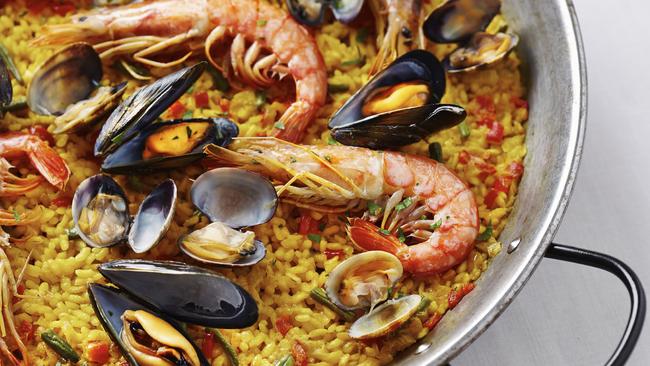Paella breakfast: clams, squid and prawns with rice, before 8am
Adhere to these fundamental rules of paella - equipment, ratios and timing - and you will be transported to Valencia.

On the greater scale of things, it was a modest sin. A sin-ette. It feels naughty — wrong, in fact — to be eating seafood paella at breakfast. With coffee. Well forgive me, father, for I have modestly sinned.
I have considered the options — yoghurt and fruit or leftover paella — and slipped into la moda Valenciana like Jorge Lorenzo into his leathers. Clams, squid and prawns with rice before 8am is a little abnormal for most of us, unless you’re in a flash hotel somewhere in Southeast Asia when vigorously flavoured savoury breakfasts somehow make complete sense.
So, why not here and now? And it was, for the record, outstanding. As it was the night before.
Now, I need you to know that I’m a harsh judge of what comes out of my own kitchen. Ambition and product barely coincide. We made stuffed Lebanese kibbeh the other night, for example, and, well, it gave me new respect for those who get ’em right. Ours were crude, to say the least.
And that’s the context for my verdict on this paella: sublime. So good, in fact, that I knew even as I put the leftovers in the fridge that resisting temptation next morning would be hard. So it proved.
Now paella is traditionally associated with Valencia because it’s a rice-growing region and I would certainly say the waterfront restaurants in that city, with their specialist paella restaurants, are something every visitor should experience at least once.
Gas burners a metre in diameter (no induction nonsense here), vast pans to fit and 10 of these going at once. And that’s one of maybe 10 such restaurants. Specialisation in any food culture is always fascinating.
Of course, the paella is brilliant and as affordable as the albarino, which is disturbingly affordable.
Yet I distinctly remember my first such meal, in 1982, sitting outdoors in Madrid, totally wet behind the ears but happy as a clam with rabbit, chicken and snails on the plate and a pretty girl to share it with.
And, as honorary Australian Rick Stein says in his book Spain, great seafood paella can be found in parts of the country that are not Valencia at all, and he goes on to reproduce a recipe stolen from some poor chap on the north coast — Cantabria, anchovy territory — that “is as good a seafood paella as you are going to find anywhere”.
I cannot disagree, even if one ingredient — mussels — was omitted and a stock made with prawn heads substituted for fish stock, which, I think, worked really well. It kind of had to.
So, you made paella I hear you say; big deal. Quite. But the catalyst was a cracking birthday present, a quantum leap in authenticity and kitchen inventory: a 40cm polished steel El Cid paella pan and matching single-ring gas burner, a kilo of bomba rice — from Calasparra in Murcia — and a tin of first-class smoked paprika. Paella for beginners. (A burner that distributes gas flame evenly across the dimpled pan is pretty much essential to do it properly).
This inspired gift had its genesis several weeks earlier as we sat on the deck at a winery cafe and watched a guy making paella like he was stir-frying noodles or sweeping a workshop, pushing it around with admirable — but totally misguided — zeal. There is one hard and fast rule for paella: stir once and wait. We rolled our eyes, commented on how much we both love good paella, and left without ordering food.
With the burner hooked up to a gas bottle, and the kit set atop the hob beneath the extraction hood, Rick’s paella de barrio pescadores became an extraordinary birthday dinner triumph.
Olive oil, garlic and shallot; red peppers and the glorious La Dalia pimenton de la vera; fresh squid, prawns and Cloudy Bay clams from New Zealand; the rice with saffron threads (not negotiable); and finally, the stock, made with the decapitated prawn heads.
Stir once. And pray, if that’s your thing.
What happens next is magic, as the rice absorbs the liquids and, if you get the timing and heat right, a thin, toasty crust — what the Spaniards call the socarrat — develops at the base.
Needless to say, the ratio of rice to liquid is fundamental, in this case 600g to 1.5 litres. It was immediately apparent we’d made enough to feed eight.
Six minutes at a vigorous simmer, 14 at something less, kill, cover, rest for five and … how do you know if you have the socarrat thing right or not?
The flavours were amazing, the texture of the rice perfect, the seafood correct, but I guess we’ll use more flame next time. The socarrat was a little, er, immature.
These are the bits of a recipe that can only be a starting point, a guideline to be honed with repeat performance. How can Rick know what size pan I’m using, what size burner, and whether my interpretation of medium heat is the same as his?
I was, nonetheless, outrageously happy with the result; it was truly like being in Valencia or even Cantabria. I almost wanted a glass of rosado with breakfast. Now that really would be a sin.
